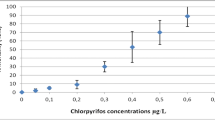Abstract
We assess the impact on water quality of thelittoral watersheds in the Northeast Region ofBrazil caused by unregulated sugar-cane farmingpractices. Virtually all water sources areimpounded because near-drought conditionspertain throughout the region. Withoutexception, these water bodies are exploitedprimarily for domestic/municipal andagricultural purposes, and secondarily as afood source. Most of the land under cultivationis used for sugar cane production. Preliminaryacute and chronic toxicity data for theherbicide paraquat, applied in sugar canefarming, are included for prawn (Macrobrachium amazonicum), snails (Pomacea lineata) and for the cladoceran Daphnia similis. They indicate a sensitivityto paraquat, orders of magnitude higher thanpredicted from literature on the biota oftemperate species, when, coupled with theprevailing limnological cycles (annual run-off,scouring, erosion, eutrophication and drought),the toxicity data suggest a hithertounsuspected level of ecological vulnerability.This underscores the need for theimplementation of an inexpensive toxicitytesting program, based on endemic speciesreflecting local conditions in NortheastBrazil.
Similar content being viewed by others
References
Anonymous, 1990. Paraquat e sua segurança no uso. (Imperial Chemical Industry) 8.
Anonymous, 1997. 3rd Delegacia do INMET. (Instituto Nacional de Metereologia).
Abilio, F. J. P., 1997. Aspectos bio-ecologicos da fauna malacologica, com enfase a Melanoides tuberculata Muller, 1774 (Gastropoda, Thiaridae) em corpos aquaticas do Estada da Paraiba. Masters Thesis, Departamento de Sistematica e Ecologia, Universidade Federal da Paraiba, João Pessoa, Brazil, 147 pp.
Aragão, R. M., B. Xavier, R. Coler & T. Watanabe, 1998. A preliminary study of respiration and excretion rates in prawn Macrobrachium amazonicum when exposed to varied flow regimes and salinities. Rev. Nordestina Biol. 12: 1-8.
Batalla, J. F., 1997. Efeito do herbicida paraquat sobre o gastrópode Pomacea lineata (Spix, 1827) (Ampullariidae, Prosobranchia): Bioensaios em laboratório. Masters Thesis, Departamento de Sistematica e Ecologia, Universidade Federal da Paraíba, João Pessoa, Brazil, 134 pp.
Brooker, M. & R. Edwards, 1974. Effects of the herbicide paraquat on the ecology of a reservoir. III. Fauna and general discussion. Freshwater Biology 4: 311-335.
Buikema, A. L., J. G. Geiger & D. R. Lee, 1980. Daphnia toxicity tests. Aquatic Invertebrate Bioassays 3: 48-69.
Ceballos, B. S. O., E. O. Lima, A. Köning & M. T. Martins, 1995. Spatial and temporal distribution of fecal coliforms, colifages, moulds and yeasts in freshwater at the semi-arid tropic northeast Brazil (Paraíba State). Rev. Microbiol. São Paulo 26: 90-100.
Coler, R. A., T. Watanabe, B. F. Xavier & R. J. Paz, 1999. A preliminary report on the application of Macrobrachium amazonicum Heller, 1862 (Decapoda: Palaemonidae) as a biomarker. Hydrobiologia 412: 119-121.
Filgueiras, H. J. A. & A. F. Silva-Neto, 2000. Estimativa de consumo de água para a irrigação na Bacia Hidrográfica do Rio Gramame. In: T. Watanabe (ed.), Bacia do Rio Gramame: Biodiversidade, uso e conservação. Prodema/UFPB, João Pessoa.
Gesteira, T. C. V., 1978. Aspectos biológicos ligados à produtividade da pesca nos açudes pÚblicos da área do "Polígono das Secas". Masters Thesis, Universidade Federal do Rio de Janeiro, Rio de Janeiro, Brazil, 135 pp.
Gonçalves, A. R., R. Abdulkader, L. Yu, P. Malheiro, E. Sabbaga, M. Marcondes & E. Burdmann, 1992. Tratamento da intoxicação por paraquat: Relato de dois casos e revisão da literatura. J. Bras. Nefrol. 14: 12-16.
Greenberg, A. E. (ed.), 1995. Standard Methods for the Examination of Water & Wastewater. American Public Health Association Publications, New York: 1100.
Hellawell, J. M., 1989. Biological Indicators of Freshwater Pollution and Environmental Management. Elsevier, London: 546.
Melo, L. E. L., R. A. Coler, T. Watanabe & J. F. Batalla, 2000. Developing the gastropod Pomacea lineata (Spix, 1827) as a toxicity test organism. Hydrobiologia 429: 73-78.
Muirhead-Thompson, R. C., 1987. Pesticide Impact on Stream fauna with Special Reference to Macroinvertebrates. Cambridge University Press, New York: 275.
Sanders, H. O. & O. B. Cope, 1966. Toxicity of several pesticides to two species of cladocerans. Trans. Am. Fish. Soc. 95: 165-169.
Sprague, J. B., 1984. Factors that modify toxicity. In: G. M. Rand & S. R. Petrocelli (eds), Fundamentals of Aquatic Toxicology. Hemisphere Publisher, New York: 124-163.
Watanabe, T., R. A. Coler and R. J. Paz, 1999. The implementation of a regional biomonitoring program in northeast Brazil. Aquatic Ecosystem Health and Management 2: 187-189.
Watanabe, T., R.B.D. Oliveira, R. Sassi, G.N. Melo, C.L. Gadelha, and V.M.N. Machado, 1994. Evidences of contamination caused by the sugar-cane monocultures and industry in water bodies of the state of Paraíba, northeast Brazil. Acta Limnol. Brasil. 5: 85-101.
Author information
Authors and Affiliations
Rights and permissions
About this article
Cite this article
Maria de Medeiros, V., Watanabe, T., Coler, R.R. et al. Development of methods to assess the impact of herbicide use on the benthos of littoral impoundments in northeast Brazil. Journal of Aquatic Ecosystem Stress and Recovery 9, 67–71 (2001). https://doi.org/10.1023/A:1013199612093
Issue Date:
DOI: https://doi.org/10.1023/A:1013199612093




